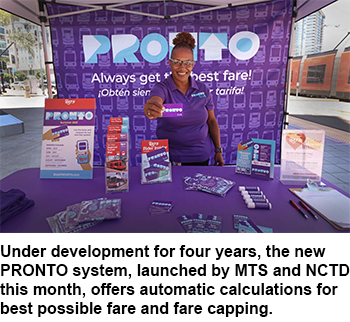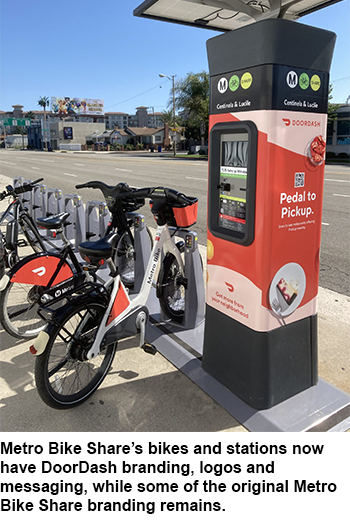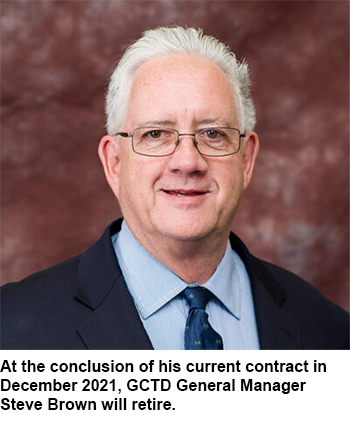The following items are excerpted from news releases issued by California Transit Association members. If you are a member of the Association and would like to submit an item to be considered for inclusion in the Member News Library, please email your press releases to Managing Editor Stephanie Jordan (sjordan@freelancecomm.com). Photos and cutline information with your news release submissions, when possible, are encouraged.
INDUSTRY NEWS
MTS and NCTD Debut PRONTO and Ride Free in September Promotion
The San Diego Metropolitan Transit System (MTS) and North County Transit District (NCTD) officially launched the region’s brand-new PRONTO fare collection system this month. MTS and NCTD are celebrating the milestone with Free Rides in September for riders with a PRONTO card or the PRONTO mobile application. PRONTO will enhance ticketing functionality, access, and value for MTS and NCTD passengers.
All riders are encouraged to get a new PRONTO card or download the PRONTO app to ride free for the entire month of September. Ride Free with PRONTO September applies to all MTS buses, Trolleys, and NCTD SPRINTER, BREEZE and Flex (no free rides on COASTER). Passengers will not need to pay but should tap a PRONTO card or scan the QR code on the app on the PRONTO validators located at rail stations and on-board buses.
“PRONTO’s features and functionality make riding transit more accessible than ever before,” said Nathan Fletcher, MTS Board Chair and Chair, San Diego County Board of Supervisors. “The system can be accessed via an app or a physical card with several different ticketing, loading, and account management options that work for everyone including our riders with disabilities or those without access to technology. PRONTO meets the needs of riders throughout the region. We hope everyone takes advantage of Ride Free with PRONTO September, reduce their carbon footprint, and learn how transit can work for them.”
Under development for four years, the new PRONTO system is more convenient, with new rider-requested functionality, and a 'best fare' system that automatically calculates the best possible fare. With PRONTO, fares are capped at $6 per day or $72 per month for adult passes ($3/day and $23/month for seniors, riders with disabilities, and youth). Passengers simply tap or scan each time they ride, and the system will automatically deduct the appropriate fare.
New rider-friendly features include:
- Free transfers – one-way fares are valid for unlimited transfers between buses and Trolleys for up to two hours
- Pay-as-you-go capabilities – riders no longer need to pay upfront for passes and can load just what they need for the day
- Instant account reloads – funds added to PRONTO accounts can be accessed instantly through the new account-based system
“The pay-as-you-go PRONTO feature will help those on fixed incomes,” said Tony Kranz, NCTD Board Chair, Deputy Mayor of Encinitas. “Allowing riders to add value to their account when they need it affords them flexibility while maintaining access to transit to get to work, health care appointments, school and entertainment.”
The PRONTO app, available for free download in the App Store and Google Play, allows riders to add money and purchase one-way fares, one-day and monthly passes as well as COASTER passes. The app will also allow riders to add value to their accounts instantly and to track their rides and progress toward earning a day pass and month pass.
Free PRONTO cards are available at participating Vons and Albertsons and more than 70 other retail outlets (some outlets may require a minimum $5 load onto the card that can be used for fares in October), as well as the Transit Center Store, and ticket vending machines.
MTS has already distributed more than 20,000 free PRONTO cards to riders at transit center outreach events throughout the month of August.
The entire PRONTO system will begin requiring fares on October 1.
U.S. Department of Transportation Announces $25 Million Funding Opportunity to Help Transit Agencies Better Serve Their Communities
The U.S. Department of Transportation's Federal Transit Administration (FTA) recently announced a Notice of Funding Opportunity (NOFO) for $25 million through the American Rescue Plan to help public transportation agencies return service from COVID-19 suspensions in ways that can best serve their communities.
Under FTA's Route Planning Restoration Program, funding can be used for transit route restoration planning that is designed to examine ridership following the COVID-19 pandemic, reduce travel times and make adjustments to increase the quality or frequency of transit service for low-income riders and those in disadvantaged neighborhoods or communities who may need increased service to get to jobs, shopping and health care.
"The Route Restoration Program will help transit agencies develop strategies and identify opportunities to remove barriers and increase equity in underserved communities," said FTA Administrator Nuria Fernandez. "The drastic changes that transit agencies have seen also will provide an opportunity for them to reimagine their systems and routes, to ensure that everyone has access to transportation."
Projects will be selected, in part, on their ability to increase racial equity and advance environmental justice, in support of the President’s Executive Order on "Advancing Racial Equity and Support for Underserved Communities Through the Federal Government." The projects will also be examined for their impact on the climate, as referenced in the President’s Executive Order on "Tackling the Climate Crisis at Home and Abroad." Transit agencies will be given additional consideration for projects that clearly reassess and plan for service that connects those in underserved communities, while helping cut down on car and other trips that increase emissions, particularly in those communities, which are often the most impacted by airborne pollution.
Eligible recipients include any urbanized area formula grant (Section 5307) recipient that has reduced transit service on or after January 20, 2020, due to COVID-19. The maximum award amount for any prospective applicant may be up to $1 million and a local match is not required. Projects will be evaluated by criteria outlined in the NOFO.
Apply by 11:59 p.m. Eastern Time on November 15, 2021.
Changes Coming to NextMuni
When the San Francisco Municipal Transportation Agency (SFMTA) first partnered with NextBus more than twenty years ago to create NextMuni, the real-time transit vehicle arrival predictions system was state-of-the-art and revolutionary for its time. As technology has advanced and our transit system has grown, we are moving to a new system that will best meet the needs of our customers.
Last year, the SFMTA Board of Directors and the Board of Supervisors approved a contract for the Next Generation Customer Information System to replace NextMuni. Set to debut in 2022, the new Customer Information System will focus on improving predictions accuracy, particularly near the beginning of routes, along with several other customer-friendly upgrades. New, larger graphical signs in transit shelters will also feature maps showing the real-time positions of vehicles. These enhancements will help improve the customer experience and make riding transit easier.
VTA Light Rail System Fully Operational Saturday, September 18
On September 18, the entire Santa Clara Valley Transportation Authority (VTA) light rail system went back on track. The Green Line, from Diridon Station to Winchester Station is the last segment of the system to be reactivated after a nearly four-month shutdown following a deadly mass shooting at the Guadalupe Light Rail Division May 26.
Part of the Green Line from Old Ironsides to Diridon Station began running trains September 12. Prior to that, as VTA light rail employees made their way back to work in the wake of the tragedy, VTA’s Orange Line and part of the Blue Line opened August 29, with the full Blue Line opening September 4. The Diridon to Winchester expansion means the entire light rail system is once again fully operational.
Free fare for light rail will continue through September 30th.
CEC Proposes Funding for Groundbreaking VTA Fleet Electrification Project
The Santa Clara Valley Transportation Authority (VTA) is included on a funding proposal list to receive a $4.68 million grant from the California Energy Commission (CEC) to fund a groundbreaking fleet electrification project. VTA will install next-generation charging infrastructure powered by an on-site microgrid to provide clean, reliable, locally-generated electricity to fuel the agency’s fleet of zero-emission, battery-electric transit buses. The CEC funding proposal list is expected to be approved in December.
“VTA’s work to reduce stress on the state’s electric grid, while converting to a zero-emission bus fleet, will benefit transit agencies across the state. We are excited and honored to have the support of the California Energy Commission on this important, groundbreaking project,” said Gary Miskell, VTA’s Chief Innovation Officer, who has guided this effort from its inception.
VTA is leading this cutting-edge electric bus charging project in conjunction with Proterra, Scale Microgrid Solutions, and Schneider Electric, with community outreach support from Lehigh University’s Institute for Cyber Physical Infrastructure and Western Regional Office.
The funding will allow VTA to complete work to deploy 1.5 megawatts of on-site solar energy at the agency’s Cerone Yard paired with a 1MW/4MWh stationary battery energy storage system and state of the art microgrid control system from Scale Microgrid Solutions. That system will help power two Proterra 1.5-megawatt fleet chargers with 34 charging dispensers. The microgrid and charging infrastructure will be linked together by a next generation switchgear and controls package designed by Schneider Electric. Clean energy generated by the new solar canopy will help lower electricity operating costs and provide increased resilience, while helping to manage stress on California’s electric grid. 
In the event of a power outage, such as a public safety power shutoff, the microgrid can provide more than 24 hours of firm electric capacity to VTA, allowing emergency transit operations to continue serving the public. The clean energy microgrid will be optimized to deliver demand flexibility to VTA, helping the agency better manage its overall electricity usage, while simultaneously reducing capacity constraints for the local grid.
Metro Bike Share Has New Look With DoorDash Ad Campaign
Metro Bike Share’s bikes and stations have a different look due to an advertising campaign by DoorDash. Bikes and kiosks now have DoorDash branding, logos and messaging, while some of the original Metro Bike Share branding remains.
The look is different, but otherwise Metro Bike Share functions the same way. Revenues from the ad campaign help Metro offset costs of the bike share program. The DoorDash ad campaign is for one year.
SunLine Transit Agency to Resume Level 1 Service
SunLine Transit Agency moved to Level 1 service beginning September 7. The Agency has been operating at Level 3 service since March 21, 2020, due to the impacts of COVID-19. The schedule change from Level 3 to Level 1 will result in SunLine buses operating with increased frequency during the weekdays.
Despite reduced service levels during the pandemic, SunLine was able to launch some of the new services the Agency has had in the planning stages since 2017 as part of the SunLine Refueled initiative. These included the introduction of the Consolidated Fixed Route and SunRide in January 2021, as well as the 10 Commuter Link in July 2021.
SunRide – a microtransit service available in four Coachella Valley zones connecting riders to the Consolidated Fixed Route Network – will be expanding in three of the four geofence zones, which will include 51 additional bus stops. Riders use this service with a smartphone app, alerting a SunRide vehicle to pick them up at a destination within the zones to bring them to and from bus stops within the same zone. SunRide has been pivotal in providing a quick and easy way for riders to access SunLine’s fixed route bus system.
The myStop Mobile App, SunLine’s trip planner, has been updated with the new Level 1 schedule. Downloadable PDF timetables, specific to each route, are also available for download on the SunLine’s website. SunLine is also offering seasonal services, such as School Trippers. With the resumption of in-person learning and students heading back to the classroom, it is essential that SunLine allocate its available resources to meet the community’s needs. Students across the Coachella Valley in high school, College of the Desert and California State University, San Bernardino make up a large percentage of SunLine’s ridership. The number of high school riders is expected to go up, as well, thanks to the newly expanded Haul Pass program – which provides local 9th – 12th grade students fare-free rides.
Even as SunLine returns to Level 1 Service, the Agency asks the community to be mindful of the fact that there is currently a nationwide shortage of bus operators, which means there may be occasions when service disruptions are unavoidable. SunLine is looking to grow its team, and encourages anyone interested in helping to keep the Coachella Valley moving to visit SunLine.org/Driver. The best way to stay up-to-date with any prospective service disruptions that may occur is to use the myStop Mobile App. SunLine actively posts updates on social media and is responsive to any feedback and questions that are submitted through its channels.
Hiking and Riding Events on OCTA Preserves Return
The Orange County Transportation Authority (OCTA) will resume hosting a series of hikes and equestrian rides on some of the county’s most pristine landscapes beginning on September 18 and continuing through the end of the year. The free hikes and rides are intended to showcase the open-space lands purchased and preserved by OCTA as part of the Measure M Environmental Mitigation Program. So far, more than 1,300 acres on seven properties have been purchased from willing landowners for preservation to offset the environmental impacts of OC Go freeway projects.
The OCTA preserves are only open to the public during the docent-led hikes and equestrian rides so that the land’s wildlife and important plant life can be protected for generations to come. The hikes and rides were halted as a safety precaution at the start of the coronavirus (COVID-19) pandemic. All participants must be 12 years or older and equestrian riders must bring their own horse. Adults must sign a liability waiver and minors need to be accompanied by a parent or guardian.
The rides are subject to cancelation due to bad weather conditions or changes in local health regulations. The full schedule and more information can be found here.
AVTA Resumes Regular Local and Commuter Service Schedules
On September 20 Antelope Valley Transit Authority (AVTA) resumed full local and commuter service to those in the AV community that count on AVTA to get them where they need to go.
“AVTA’s return to full local and commuter service levels are a big part of helping Antelope Valley residents and businesses return to normal routines,” stated AVTA Board Chairman Marvin Crist. “Be assured that AVTA will continue to uphold the health and safety of our passengers and employees as our top priority.”
Recent studies show that public transportation is safe. There is no identified correlation with the spread of the coronavirus and the use of public transportation. However, both Federal and County Law require masks or face coverings be worn at all times in transportation centers, at bus stops, and on all public transportation vehicles. Failure to comply constitutes a violation of Federal law.
Visit the AVTA website to download the new Local Transit Service and Commuter Service maps and schedules brochures. The new schedules can also be found at the AVTA office in Lancaster.
Routes 747 and 748 did not resume service to Edwards Air Force Base and Mojave Air and Space Port on September 20. AVTA is currently working to resume these routes as soon as possible.
TRANSIT PEOPLE AND HAPPENINGS
GCTD’S General Manager Steve Brown Announces Retirement 
After a career spanning over 43 years in the transit industry, Gold Coast Transit District’s General Manager, Steven P. Brown, announced this month that he will retire as head of the largest public transit agency in Ventura County, when his contract expires at the end of December 2021. Brown joined GCTD in 2006 as the Director of Planning and Marketing and has served as General Manager since 2010, where he leads an agency of over 200 employees with a $31-million annual budget.
Brown departs GCTD after an extensive career in public transit, holding previous roles including Deputy Public Transit Director for the City of Phoenix, Manager of Bus System Improvement Planning for LA Metro, running his own transportation consulting firm, and was the Director of Planning and Marketing for Phoenix Transit.
"We are grateful for Brown's leadership during the past 15 years," said GCTD Board Chair and Ojai Councilmember Randy Haney. "He has provided us with steady leadership and has set the agency up for a successful future, with a new facility and a dedicated staff who are ready to keep moving the agency forward.”
Under Brown's leadership, GCTD earned the “Small Agency of the Year” award in 2014 by the California Transit Association, after transitioning the organization from a Joint Powers Authority into a Special Transit District. This effort enabled the District member jurisdictions to efficiently use their locally generated Transportation Development Act funds to provide a seamless transit system in Western Ventura County dedicated to high quality public transit. The District has since launched several new bus routes, along with innovative on-demand services such as Late Night Safe Rides and completed one of the largest transit infrastructure projects in Ventura County’s history, the 15-acre Operations and Maintenance Facility, which opened in 2019.
Brown will continue to serve through the end December 2021 when his current contract expires. In the coming weeks, the Board will work to initiate a recruitment process. Brown has committed to working with the Board on a transition plan to ensure a smooth hand off to the next leader.
Caltrain Announces New Leadership for Electrification Project
As the Caltrain Electrification civil infrastructure is successfully headed towards completion, Caltrain Modernization (CalMod) Chief Officer John Funghi will be leaving at the end of this year. Funghi will be working until October 15, 2021 and then plans to take a well-deserved leave to the end of this year. The agency is transitioning the project to new leadership to ensure a successful outcome resulting in passenger service with high-performance electric trains by 2024.
The agency is pleased to announce the appointment of Pranaya Shrestha as the Interim Chief of the Caltrain Modernization Program. Shrestha has 30 years of rail experience, including experience with 25kV AC commuter rail and DC light rail systems, and design-build project delivery successes with federal recognition. He has finished 19 major transit projects totaling more than $9 billion, and has worked on transit projects in Denver, Los Angeles, San Francisco, Portland, Orlando, and Seattle.
Shrestha has worked with the Federal Transit Administration (FTA) and has established solid working relationships that have resulted in positively delivering federally funded projects. He is currently a HNTB consultant and will be on property 100 percent dedicated to the $2.3 billion Electrification project.
Much of the civil infrastructure work for the Electrification project is progressing as expected. The majority of the work remaining, with risk, relates to the signal and systems integration work. The start of electrification testing is scheduled to start before end of the year.
“We would like to sincerely thank John Funghi for his more than three years of service to the railroad,” said Caltrain Board Chair Dev Davis. “His leadership has allowed the project to advance construction significantly with a trajectory for electrified revenue service by 2024.”
 RTD CEO Recruitment Begins as Incumbent Announces Retirement
RTD CEO Recruitment Begins as Incumbent Announces Retirement
San Joaquin Regional Transit District (RTD) launches recruitment efforts for its next Chief Executive Officer (CEO) as current CEO Gloria G. Salazar announces her retirement set for February 2022. The recruitment is being conducted by Krauthamer & Associates.
“Despite the pandemic, exciting things are happening at RTD as we continue to fulfill our electrification, business recovery, and technology innovation goals,” said CEO Gloria G. Salazar. “In addition to an excellent Board that fully supports the CEO, RTD has a group of committed employees, infrastructure and fleet both in a state of good repair, and a sustainable business plan with no commercial debt. RTD is a thriving organization in an ideal position, ready for the next CEO.”
Salazar assumed the role of RTD’s Chief Executive Officer in January 2020 with 28 years of experience in the transit industry. Her leadership as Deputy CEO/CFO for 18 years significantly contributed to RTD receiving the coveted Outstanding Transit System of the Year Award by the American Public Transportation Association (APTA) in 2018 and an Excellence for Financial Reporting Award for 17 consecutive years. As CEO, she successfully negotiated a labor contract for the first time since 2003 and navigated RTD through the pandemic while moving capital projects and a system redesign study forward.
“We thank Gloria for her 20 years of dedication and service to all RTD customers, staff, and community partners,” said Chairman of the Board Michael Restuccia. “She will leave behind a financially and fiscally healthy organization with excellent and dedicated staff. We will find a good candidate who can step in and continue advancing RTD’s vision and mission.”
Autumn Bernstein Selected as New Executive Director of the Yolo County Transportation District
The Yolo County Transportation District (YCTD) Board of Directors recently approved an agreement with Autumn Bernstein to become the new YCTD Executive Director. Most recently, she served as an Associate for Arup in their Bay Area Integrated Planning Team, leading the team’s equity practice. She managed projects for public and private clients, including BART, the Sacramento Area Council of Governments, Stanford University, and the San Mateo County Transportation Authority.
As Principal at Estolano LeSar Advisors, an equity-focused urban planning and public policy firm, Bernstein established the firm’s first satellite office in the San Francisco Bay Area, where she won and managed contracts with clients including the Metropolitan Transportation Commission and the California Strategic Growth Council. Notably, Bernstein is the founding Executive Director of ClimatePlan where she built and spearheaded a diverse statewide network to implement SB 375, California’s groundbreaking policy to advance sustainable communities and multimodal transportation.
The YCTD Executive Director is responsible for creating an economically and environmentally sustainable transportation program that provides continuity throughout the transit systems in the region. Under the guidance of the Board of Directors, the Executive Director is responsible for a broad range of assignments including transportation management, personnel, finance, and implementing a robust communication program with stakeholders and partner agencies.
Bernstein took the reins as YCTD Executive Director on September 1.